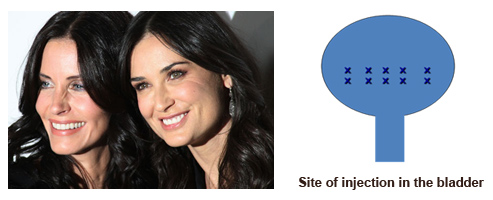- Urinary Incontinence and voiding dysfunction
- Men: Stress Urinary Incontinence
- Men: Pelvic Floor Rehabilitation
- Men: Transurethral Injection of Bulking Agents
- Men: Male Slings
- Men: Artificial Urinary Sphincter (AUS)
- Men: Adjustable continence device (Pro-ACT ) (Investigational)
- Women: Stress Urinary Incontinence
- Women: Pelvic Floor Rehabilitation
- Women: Transurethral Injection of Bulking Agents
- Women: Minimally Invasive Slings
- Women: Adjustable Continence Device
- Urge Incontinence in men and women
- Behavior Modification, Pelvic floor Rehabilitation and Biofeedback
- Botox Injection
- Sacral Neuromodulation
- Percutenous Tibial Nerve Simulation (PTNS)
Botox Injection

Botox is well known for ironing out wrinkles, with many people reportedly benefiting from its cosmetic effects. But it’s now making a new name for itself in bladder control. That’s right it’s now being used to iron out the bladder. A simple injection of the toxin into the bladder lining could bring relief to some of the nearly 13 percent of American men and 37 percent of American women who, are affected by urinary incontinence

The procedure is commonly performed in the office or surgi-center under local anesthetic.
A special scope is used to inject Botox into the muscle of the bladder. The procedure usually takes about 20-30 minutes.
The procedure is usually well tolerated with minimal side effects. You might experience some burning when you urinate the first few times after the procedure. You may also see some blood in the urine. Significant bleeding is rare. You should start seeing the effect of Botox in as little as two weeks. Botox usually lasts for 6-9 months. After being approved by FDA, most insurance companies cover the procedure, however, prior authorization is necessary in most cases

